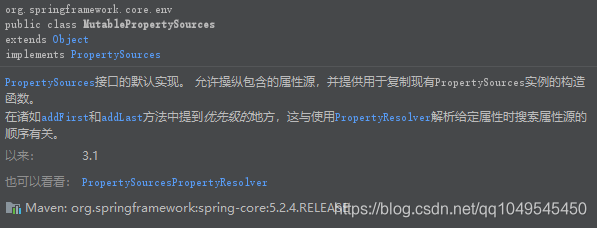StandardServletEnvironment
前情回顾
前面有讲到ConfigurableEnvironment,然后springBoot启动的时候就会去准备环境,根据webApplicationType选择策略,我们当前的demo中选择的环境类型是servlet,所以我们本文重点来看看StandardServletEnvironment。

继承与实现关系
我们先看看StandardServletEnvironment的继承关系,最上面是从AbstractEnvironment继承来的:

根据类的初始化过程,我们先看看AbstractEnvironment的无参构造方法:
/**
* 自定义在调用getProperty(String)和相关方法期间此Environment要搜索的PropertySource对象集。
* 鼓励重写此方法的子类使用MutablePropertySources.addLast(PropertySource)添加属性源,以使其他子类可以调用具有可预测结果的super.customizePropertySources() 。 例如:
* public class Level1Environment extends AbstractEnvironment {
* @Override
* protected void customizePropertySources(MutablePropertySources propertySources) {
* super.customizePropertySources(propertySources); // no-op from base class
* propertySources.addLast(new PropertySourceA(...));
* propertySources.addLast(new PropertySourceB(...));
* }
* }
*
* public class Level2Environment extends Level1Environment {
* @Override
* protected void customizePropertySources(MutablePropertySources propertySources) {
* super.customizePropertySources(propertySources); // add all from superclass
* propertySources.addLast(new PropertySourceC(...));
* propertySources.addLast(new PropertySourceD(...));
* }
* }
*
* 在这种安排下,将按照源A,B,C,D的顺序解析属性。 也就是说,属性源“ A”优先于属性源“ D”。 如果Level2Environment子类希望为属性源C和D提供比A和B更高的优先级,则可以在之后而不是在添加其自身之前简单地调用super.customizePropertySources :
* public class Level2Environment extends Level1Environment {
* @Override
* protected void customizePropertySources(MutablePropertySources propertySources) {
* propertySources.addLast(new PropertySourceC(...));
* propertySources.addLast(new PropertySourceD(...));
* super.customizePropertySources(propertySources); // add all from superclass
* }
* }
*
* 现在,根据需要,搜索顺序为C,D,A,B。
* 除了这些建议之外,子类还可以使用任何add* , remove或replace MutablePropertySources公开的方法,以创建所需属性源的精确排列。
* 基本实现未注册任何属性源。
* 请注意,任何ConfigurableEnvironment客户端都可以通过getPropertySources()访问器(通常在ApplicationContextInitializergetPropertySources()进一步定制属性源。 例如:
* ConfigurableEnvironment env = new StandardEnvironment();
* env.getPropertySources().addLast(new PropertySourceX(...));
*
* 有关实例变量访问的警告
* 在子类中具有默认的初始值声明实例变量不应该从这个方法中访问。 由于Java对象创建生命周期的限制,当AbstractEnvironment()构造函数调用此回调时,尚未分配任何初始值,这可能导致NullPointerException或其他问题。 如果需要访问实例变量的默认值,请将此方法保留为空操作,并直接在子类构造函数中执行属性源操作和实例变量访问。 注意,给实例变量赋值是没有问题的。 它只是试图读取必须避免的默认值。
* @see MutablePropertySources
* @see PropertySourcesPropertyResolver
* @see org.springframework.context.ApplicationContextInitializer
*/
protected void customizePropertySources(MutablePropertySources propertySources) {
}
MutablePropertySources
先看看初始化需要用到的参数MutablePropertySources是什么意思:

MutablePropertySources类中包含一个存放PropertySource的集合,然后提供了这个集合的操作方法。应该就是为后面读取Property准备的。
private final List<PropertySource<?>> propertySourceList = new CopyOnWriteArrayList<>();
自定义属性源
StandardEnvironment#customizePropertySources
接下来看看customizePropertySources是怎么操作的,可以怎么玩,根据继承关系,先执行的是org.springframework.core.env.StandardEnvironment#customizePropertySources:
/** 系统环境属性源名称 */
public static final String SYSTEM_ENVIRONMENT_PROPERTY_SOURCE_NAME = "systemEnvironment";
/** JVM系统属性源名称*/
public static final String SYSTEM_PROPERTIES_PROPERTY_SOURCE_NAME = "systemProperties";
/**
* 使用适用于任何标准Java环境的属性定制属性源集:
* “系统属性”
* “ systemEnvironment”
* 目前在属性“systemProperties”将优先于“systemEnvironment” 。
* @see AbstractEnvironment#customizePropertySources(MutablePropertySources)
* @see #getSystemProperties()
* @see #getSystemEnvironment()
*/
@Override
protected void customizePropertySources(MutablePropertySources propertySources) {
propertySources.addLast(
new PropertiesPropertySource(SYSTEM_PROPERTIES_PROPERTY_SOURCE_NAME, getSystemProperties()));
propertySources.addLast(
new SystemEnvironmentPropertySource(SYSTEM_ENVIRONMENT_PROPERTY_SOURCE_NAME, getSystemEnvironment()));
}
可以看到,先加载的是JVM系统配置的属性源,然后才是系统里面配置的。按照AbstractEnvironment的规则,JVM里面的配置优先级高于系统配置。
getSystemEnvironment
先看看系统环境怎么获取的:
@Override
@SuppressWarnings({"rawtypes", "unchecked"})
public Map<String, Object> getSystemEnvironment() {
if (suppressGetenvAccess()) {
return Collections.emptyMap();
}
try {
return (Map) System.getenv();
}
catch (AccessControlException ex) {
return (Map) new ReadOnlySystemAttributesMap() {
@Override
@Nullable
protected String getSystemAttribute(String attributeName) {
try {
return System.getenv(attributeName);
}
catch (AccessControlException ex) {
if (logger.isInfoEnabled()) {
logger.info("Caught AccessControlException when accessing system environment variable '" +
attributeName + "'; its value will be returned [null]. Reason: " + ex.getMessage());
}
return null;
}
}
};
}
}
小知识又多了点:
可以通过配置来控制springBoot是否读取系统环境:suppressGetenvAccess
可以通过配置spring.getenv.ignore为true来避免读取系统环境配置。
不过spring.getenv.ignore的值默认是false,并且也没遇到过哪里配置成true的。[手动捂脸]
看下System.getenv();能得到啥就不说了,自己电脑跑下就可以了。
getSystemProperties
再看下从jvm系统里面读属性又读了些啥嘛:
@Override
@SuppressWarnings({"rawtypes", "unchecked"})
public Map<String, Object> getSystemProperties() {
try {
return (Map) System.getProperties();
}
catch (AccessControlException ex) {
return (Map) new ReadOnlySystemAttributesMap() {
@Override
@Nullable
protected String getSystemAttribute(String attributeName) {
try {
return System.getProperty(attributeName);
}
catch (AccessControlException ex) {
if (logger.isInfoEnabled()) {
logger.info("Caught AccessControlException when accessing system property '" +
attributeName + "'; its value will be returned [null]. Reason: " + ex.getMessage());
}
return null;
}
}
};
}
}
好像也没啥东西。过……
StandardServletEnvironment#customizePropertySources
再来看看org.springframework.web.context.support.StandardServletEnvironment#customizePropertySources:
/** Servlet上下文初始化参数属性源名称:“ servletContextInitParams” */
public static final String SERVLET_CONTEXT_PROPERTY_SOURCE_NAME = "servletContextInitParams";
/** Servlet配置初始化参数属性源名称:“ servletConfigInitParams”。*/
public static final String SERVLET_CONFIG_PROPERTY_SOURCE_NAME = "servletConfigInitParams";
/** JNDI属性源名称:“ jndiProperties”。 */
public static final String JNDI_PROPERTY_SOURCE_NAME = "jndiProperties";
/**
* 使用超类提供的属性源以及适用于基于标准servlet的环境的属性源来定制属性源集:
* “ servletConfigInitParams”
* “ servletContextInitParams”
* “ jndiProperties”
* 在本属性“servletConfigInitParams”将接管那些优先在“servletContextInitParams” ,并且在任一上述优先于那些在发现的发现属性“jndiProperties” 。
* 以上任何一项中的属性都将优先于StandardEnvironment超类提供的系统属性和环境变量。
* 与Servlet相关的属性源在此阶段作为stubs添加,并且在实际的ServletContext对象可用时将被完全初始化。
* @see StandardEnvironment#customizePropertySources
* @see org.springframework.core.env.AbstractEnvironment#customizePropertySources
* @see ServletConfigPropertySource
* @see ServletContextPropertySource
* @see org.springframework.jndi.JndiPropertySource
* @see org.springframework.context.support.AbstractApplicationContext#initPropertySources
* @see #initPropertySources(ServletContext, ServletConfig)
*/
@Override
protected void customizePropertySources(MutablePropertySources propertySources) {
propertySources.addLast(new StubPropertySource(SERVLET_CONFIG_PROPERTY_SOURCE_NAME));
propertySources.addLast(new StubPropertySource(SERVLET_CONTEXT_PROPERTY_SOURCE_NAME));
if (JndiLocatorDelegate.isDefaultJndiEnvironmentAvailable()) {
propertySources.addLast(new JndiPropertySource(JNDI_PROPERTY_SOURCE_NAME));
}
super.customizePropertySources(propertySources);
}
根据规则,属性配置源的优先级:servletContextInitParams > servletConfigInitParams > jndiProperties > systemProperties > systemEnvironment;
加接来再看看servletContextInitParams 、servletConfigInitParams 、 jndiProperties 的配置属性;
servletContextInitParams和servletConfigInitParams 的配置对象都是通过初始化StubPropertySource来配置的,那就先看看StubPropertySource的注释。

也就是说目前还不能确定配置的值,先用个属性源占个坑,然后等上下文刷新的时候再用值来替换。好吧,那就先看看jndiProperties 的配置吧。
是否启动JNDI配置的开关:
JndiLocatorDelegate.isDefaultJndiEnvironmentAvailable())
/**
*检查在此JVM上是否有默认的JNDI环境(如Java EE环境)。
* @return {@code true} if a default InitialContext can be used,
* {@code false} if not
*/
public static boolean isDefaultJndiEnvironmentAvailable() {
if (shouldIgnoreDefaultJndiEnvironment) {
return false;
}
try {
new InitialContext().getEnvironment();
return true;
}
catch (Throwable ex) {
return false;
}
}
private static final boolean shouldIgnoreDefaultJndiEnvironment = SpringProperties.getFlag(IGNORE_JNDI_PROPERTY_NAME);
/**
指示Spring忽略默认JNDI环境的系统属性,即始终从isDefaultJndiEnvironmentAvailable()返回false 。
默认值为“ false”,允许常规的默认JNDI访问,例如在JndiPropertySource 。 将此标志设置为true是一种优化方案,该方案从一开始就找不到此类JNDI后备搜索,从而避免了重复的JNDI查找开销。
请注意,此标志仅影响JNDI后备搜索,而不影响显式配置的JNDI查找(如针对DataSource或其他环境资源的查找)。 从字面上看,该标志仅影响尝试基于JndiLocatorDelegate.isDefaultJndiEnvironmentAvailable()检查进行JNDI搜索的代码:特别是StandardServletEnvironment和StandardPortletEnvironment
*/
public static final String IGNORE_JNDI_PROPERTY_NAME = "spring.jndi.ignore";
这里默认是false。
对于JNDI是什么,我也不是很了解,只是在以前的工作中用过,当时是把JNDI配置到Tomcat中,然后程序里面通过JNDI的配置来获取数据源,后面用了Spring后就没遇到过了。这里找了篇文章,可以参考下。JNDI学习总结(一):JNDI到底是什么?

